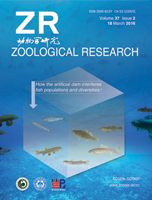
|
Zoological Research
Kunming Institute of Zoology, Chinese Academy of Sciences
ISSN: 2095-8137
Vol. 32, No. 1, 2011, pp. 40-49
|
 Bioline Code: zr11007
Bioline Code: zr11007
Full paper language: Chinese
Document type: Research Article
Document available free of charge
|
|
|
Zoological Research, Vol. 32, No. 1, 2011, pp. 40-49
| en |
Identification of the TRIM5/TRIMCyp heterozygous genotype in Macaca assamensis
Cao, Guang; Nie, Wen-Hui; Liu, Feng-Liang; Kuang, Yi-Qun; Wang, Jin-Huan; Su, Wei-Ting & Zheng, Yong-Tang
Abstract
The lack of appropriate animal models that utilizes HIV-1 as the challenge virus is a major impediment to HIV/AIDS research. A major reason underlying the inability of HIV-1 to replicate in nonhuman primate cells is the existence of host antiviral restriction factors. The intrinsic antiviral proteins in host cells are described as restriction factors. The understanding of restriction factors and their mechanism in different primates would undoubtedly facilitate the development of HIV/AIDS animal models. TRIM5α is an important restriction factor and can restrict the infection of several retroviruses including HIV-1 in a species-specific fashion. TRIM5-cyclophilin A (TRIMCyp) gene is an unusual TRIM5 locus found in New World and Old World monkeys. The different TRIMCyp genotypes of four primates (110 samples) including assam macaque (Macaca assamensis), tibetan macaque (M. thibetana), stump-tailed macaque (M. arctoides) and Chinese rhesus macaques (M. mulatta) were studied in this paper. We firstly found that TRIM5-CypA fusion gene exist in M. assamensis. The TRIMCyp of M. assamensis also results from the retrotransposition of CypA pseudogene cDNA into 3'-UTR of TRIM5 gene like TRIMCyp of M. leonina. Moreover, there is an extremely high sequence homology between TRIMCyp genes from M. assamensis and M. leonina. Besides, we also found the G-to-T mutation (G/T) in the 3'splicing site of TRIM5 intron 6, which was identical to M. leonina. These results indicateM. assamensis may also encode TRIMCyp protein like M. leonine, which imply M. assamensis might be infected by HIV-1. Therefore, it is very possible thatM. assamensis will be used as a new HIV/AIDS animal model.
Keywords
Macaca assamensis, Restriction factor, TRIM5α, TRIMCyp , Heterozygous genotype, HIV, Animal model
|
| |
© Copyright 2011 Kunming Institute of Zoology, the Chinese Academy of Sciences
Alternative site location: http://www.zoores.ac.cn/
|
|
